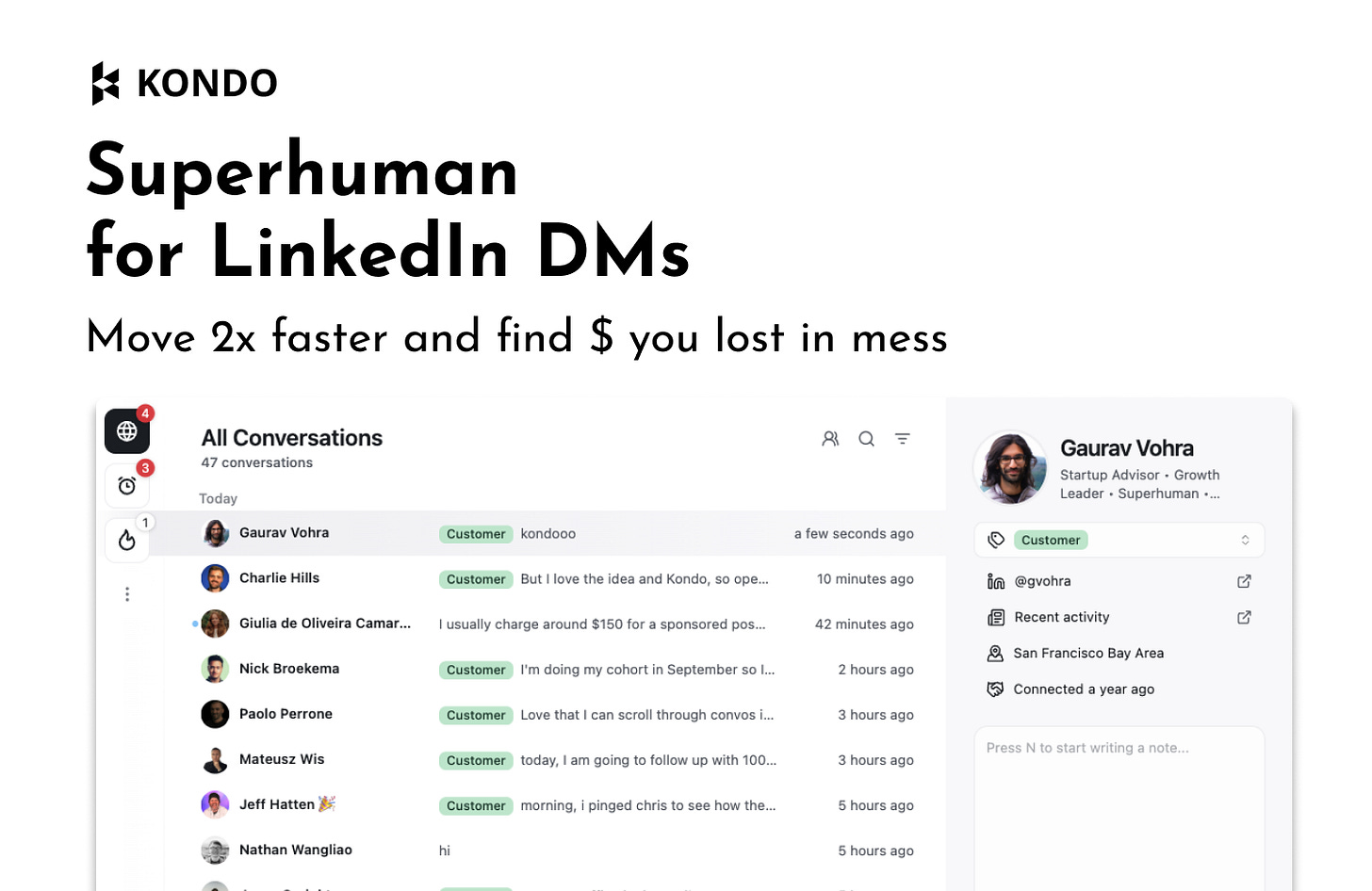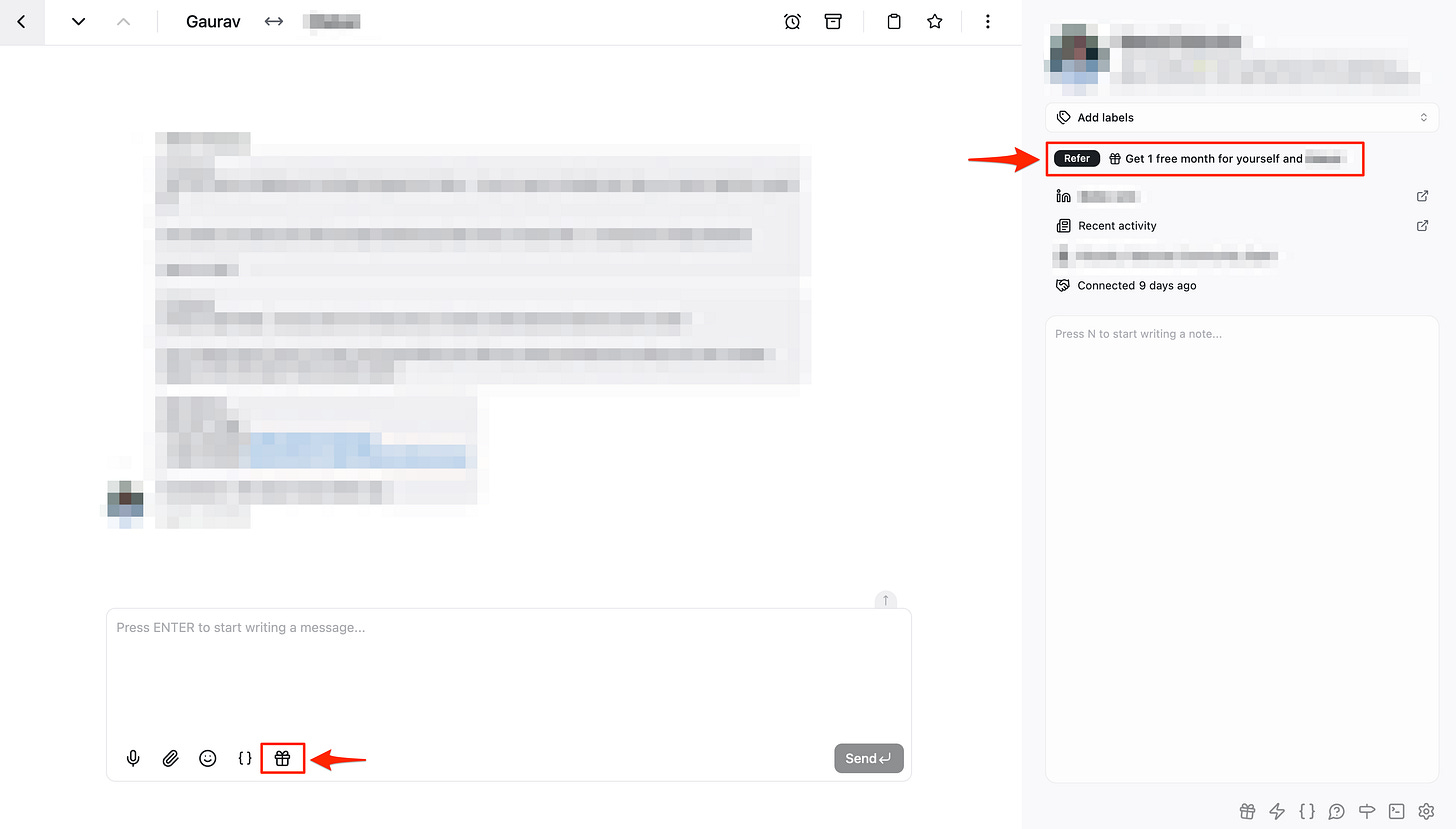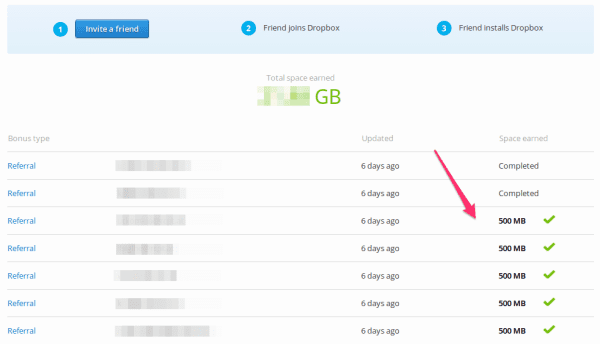The Ultimate List Of Referral Optimizations 🎁
Over 50 referral optimizations in one crisp list
Brought to you by Kondo: Superhuman for LinkedIn.
If you get a lot of DMs, you're likely losing opportunities in the mess. Kondo fixes that.
I use Kondo to find hidden opportunities lost in my DMs. Split inboxes, reminders, snippets, and keyboard shortcuts built in. Your first month free (worth $30) here.
Referrals are a growth dream:
Low cost
High conversion
Low churn
If you have product-market fit, customers are probably already recommending your product.
Referrals let you double down on this love.
In its early days, customers were eager to recommend Superhuman, but they had no easy way to do it.
I did what any sensible growth person would do. I hacked together and shipped our MVP referral feature.
How it worked:
Hit 🎁
Enter email address
Send
Before I knew it, referrals were an astounding 30% of weekly customer mix.
There were dozens of further optimizations. So we did those things.
Weekly referrals tripled.
The best part? The channel delivered year after year — and still does.
Startups always have and always will grow through referrals. It comes up constantly at startups I advise. And the playbook is long and intricate.
I got tired of repeating myself (!) so I wrote it all down.
To that end, I present: The Ultimate List of Referral Optimizations.
This is for founders, growth, and product people.
Preconditions for referrals
Get clear on definitions
If you aren’t clear on definitions, you and your entire team will go nuts.
Please let me save you the headache:
Referrer: The person making a referral.
Referee: The person being referred.
Referral: What the referrer gives the referee.
Next, let’s clarify channels:
Referral is when a customer recommends your product in a way that is measured and tracked by your product.
Word of Mouth is when this happens in an untracked way.
Do not conflate referrals with Add to Team, which is about growing within a logo. I’ll write a separate essay on Add to Team.
Ensure referrals make sense for your business
Referrals make sense:
For B2C companies acquiring more customers.
For B2B companies landing new logos.
Referrals are a good fit when:
Your product is not so expensive that it would be weird to recommend to a friend.
Imagine the friction of referring a product that will cost the referee >$50k per year.
Rule of thumb: under $500 a year is the sweet spot for B2C, and under $5k for B2B.
It is easy for users to identify who specifically would be a good person to refer.
In B2C, this is mostly a question of customers identifying “who do I know who is like me?”
In B2B, this involves your customer identifying both which company needs your solution and which individual to contact.
Easier in product-led B2B, where your users can just think about other users like themselves.
Harder in sales-led B2B, where your users might not know the right person to contact.
Ensure you are ready to invest in referrals
Typical conditions:
Product love: high product-market fit, high retention, high net promoter score.
You already see word of mouth: customers share your product organically.
It might be too early to invest in referrals if you don’t see these signs.
Work on product instead. Boost customer love.
Buy vs. build.
By the time you read the full playbook, you might be nervous about the amount of infrastructure necessary.
Consider integrating a referral service from this list to save effort.
Now, the playbook.
The Ultimate Referral Playbook
Step 1: Get referral basics in place
The first step is to create low-friction ways for customers to refer.
Customers already want to recommend your product.
So create pathways to create a behavior loop.
Give users a referral link that they can share anywhere they want.
Copy link to clipboard in one click or tap.
Optionally include some persuasive text when the link is copied (“I think you'll like Kondo. Here's a link for 1 month free https://app.trykondo.com/referral/2FB3V1”).
Create clear referral entry-points throughout the app.
Make entry-points extremely visible from the app home screen. Making it visually indistinguishable drops engagement 3x. Burying it beneath a click drops engagement 10x.
Use words (“Refer”) to make the action crystal clear.
Use iconography (“🎁”) to create visual identity.
If appropriate, pick a color for further visual identity.
Add a keyboard-driven method accessible anywhere in the app. For example, if your app has a Command Palette, implement Cmd+K → Refer.
Support all platforms: Desktop, mobile, web admin, and any others.
Instrument and optimize everything:
When existing customers engage with the new referral entry points.
When the referral link is copied to clipboard.
When the referral link is clicked by referees.
When a signup converts via the referral link.
How well those customers retain.
For now, we are not remotely concerned with adding incentives, financial or otherwise. We are simply tapping into existing motivation.
But wait. Isn’t it obnoxious for customers to refer if there’s no incentive?
Not if they love your product so much that they want to share it with friends. If you really have found product-market fit, your customers will already organically refer other customers.
You might well have some storytelling around why customers might want to refer in the absence of an incentive:
Perhaps you’re running a waitlist in closed beta, and you’re making it so that referrers can help referees jump the queue.
Perhaps your product’s value increases when there are more connections between users, like in consumer social. In this case, giving customers the ability to refer directly benefits them.
Step 2: Layer referral incentives on top
With the basics in place, we turn to incentives.
The critical thing to remember is that incentives are primarily an excuse to communicate with your customers about the ability to refer.
The details of the incentive also matter. But not as much as the excuse to message them about it.
Create a two-sided incentive.
Both the referrer and the referee receive something in return for a successful referral.
Unless you have an extremely strong reason otherwise, make the incentive symmetric. If nothing else, it’s easier to express in copy: “You and your friend both get XYZ”.
Make the incentive conditional on a successful referral, not just making the referral.
The referee must get deep enough into the user journey to be considered high-quality growth.
Usually, this is the point where the referee would pay, or when they have reached sufficient product usage depth.
For example, Wispr Flow unlocks the symmetric referral bonus when the referee either pays or hits 2,000 words (which is the primary threshold to shift from free → paid).
Express the incentive as cash.
In SaaS, you might be used to seeing: “You and your friend both get a free month”. But humans typically respond more favorably to cash: “You and your friends both get $20”. Cash feels instant and concrete. A free month requires context.
Don’t just express a free month incentive as cash; actually make it cash.
When it comes to incentivizing customer referral programs, there are two options: offer discounts on your products or offer cash (or an equivalent). In most cases, cash is king.
— Cash is king for customer referrals, TremendousUse a vendor like Tremendous to abstract away logistics.
Update the journey to remind referrers and referees of the incentive.
Referrers should see mention of the incentive at all points in the journey of referring. Every bit of explanatory microcopy should remind them.
Referees should be notified of the incentive in all messages, landing pages, and sign-up screens.
Notify referrers and referees when their incentives kick in.
Thank referrers when they successfully refer and when the referee successfully joins. In these messages, remind them about the incentive.
Notify referees when their reward is unlocked. In this message, prompt them to start referring.
Create incentive depth. Remember, incentives are primarily about reasons to message, so it’s a good thing to keep changing them.
Add more incentive as the referee gets deeper into the product.
You might give both sides $10 when the referee starts a subscription, and another $10 when they pass a usage threshold.
This is especially powerful if the referrer has some ability to influence the referee’s usage.
Increase the incentive as referrers refer more to drive continued activity.
Layer non-monetary incentives like swag giveaways, invites to exclusive events, and public recognition.
An incentive will inevitably add volume to the top of your funnel.
However, it will also cause average referral quality to decline. This will show up in conversion and retention.
Unless you’ve really messed something up, the former should outweigh the latter. So don’t be alarmed when you see referral to customer conversion tank, and month 1 customer churn spike.
Keep calm and measure incremental impact on the number of new customers retained past month 2.
Step 3: Market the heck out of your referral program
Your referral program lives and dies by how many of your customers know about it.
So make sure your entire customer base is made aware.
Launch the referral program to the entire customer base.
Notify customers in-app, via notifications, over email, and any other communication channel available.
Allow them to opt out of this type of communication without harming their ability to receive other messages, of course.
Routinely run referral campaigns with your entire customer base.
I find the sweet spot is 2-4 times a year. Much more and customers might experience message fatigue and run out of people to refer.
Connect promotions with meaningful customer moments. For example, at Superhuman, we ran referral promotions during Inbox Zero Week and in the first week of the year to tap into the “new year, new me” feeling.
Use a deadline to create urgency.
Front-load the ask at the beginning of the new user journey.
Create an interruptive full-screen ask that tells all new customers about the ability to refer, and the incentive.
Founders often balk at asking new customers to refer so early in their journey. But when an incentive is at stake, many customers are very happy to hear about the offer — especially in B2C. Everyone else will ignore it without further thought.
Prompt users to refer at moments of peak happiness.
This makes the most sense when they’ve completed some action that demonstrates product love. Think reaching a streak milestone in Duolingo, or giving a 5* Airbnb rating.
Mention the ability to refer throughout lifecycle messaging.
Advertise the ability to refer as a “ps” or “by the way” in your activation emails.
Include a dedicated email in your activation sequence about the ability to refer so that all new customers are made aware.
Make mentioning referrals a standard part of your new product announcement messages.
Create an ‘insiders’ group of your top referrers with ongoing fun and community-oriented messaging.
Step 4: Make your app a referral machine
You now have a well-structured and well-advertised referral mechanism.
Next, turn your app into a referral machine.
Don’t just rely on users sharing a link. Create the ability for your app to directly message referees on behalf of referrers.
Pre-write the message to make it easier for users to hit “send”. Let referrers tweak it if they desire.
Make this message look like a real message from the referrer, not a generic-looking message from a company.
Include information that goes beyond “I like this tool”. For example, include usage statistics that show the referrer is getting value.
If possible, suggest specific referees. Make this as simple as tapping a few names and faces. Of course, this requires that your app has access to a user’s contacts.
Add a way for users to import contacts and provide a strong reason to do so. Maybe the product functions better with it, or maybe the referral incentive is reason enough!
Sort the list to put the ‘best’ recommendations at the top. Use whatever signal you might have. At Superhuman, this is easy: we look at who the customer emails a lot. Other techniques include cross-referencing the contact list with your “signed up, but hasn’t paid” list, or prioritizing a pre-defined list of logos.
If you’re extremely confident in the recommendations, add a “select all” checkbox, and pre-select it, removing all friction!
Suggest referees in targeted and specific contexts.
For example, Kondo has a “refer” button in the sidebar when you look at a particular user’s profile, and in the conversation with that user.
Create a referral dashboard for users.
A basic requirement is showing the list of referrals made, in progress, and completed. See early Dropbox for inspiration.
The dashboard should make users feel good by showing total credit earned. It should make them take action by showing total credit on the table.
Finally, it should have a “remind” button to nudge referees.
Step 5: Combine referrals with other channels: casual contact, social, community, influencer, affiliate, and add to team
At the heart of every great growth strategy is a collection of mutually reinforcing channels.
Referrals are often one of them.
Combine referrals with casual contact loops. A casual contact loop is any time a user using your product results in someone new seeing it. Think sharing a Loom, Figma, or DocuSign.
Embed your user’s referral link into any content they might share using your app.
For example, “Sent via Superhuman” email signature is each user’s referral link, letting them emit referral links and earn incentives just by using the app.
It’s common to provide the ability to turn this off, but only on higher-tier plans.
Combine referrals with social.
Make the referral link extremely easy for customers to post to social. Two clicks max: One to express intent, one to post.
If you have user-generated content or brag-worthy usage statistics, have a low-friction way for users to share on social, and include the referral link.
Combine referrals with community.
Create a public micro-site that identifies and thanks your top referrers. Reset this list every month to keep it fresh.
Notify them and let them do their magic in bragging about it.
Notify others to get them to compete for primacy.
Create a private community for your top referrers.
Combine referrals with affiliate and influencer.
Use the same referral program and infrastructure with affiliates and influencers. Build once, use thrice!
Advertise these programs in your app to continuously recruit customers with large audiences. The ‘refer’ screen is a perfect place for this.
If you also have an ‘add to team’ flow to drive team expansion, make it work alongside your ‘refer’ flow.
Start by deciding which to prioritize. Why? There will be situations where you can only pick one. Examples include limited pixels on screen or a finite ability to blast your customer base.
In my experience, a dollar of team expansion is worth more than a dollar of new logo. In this case:
Re-capture referrals as team adds where you think the user might want to grow their team, for example, if a user makes a same-domain referral like adam@acme.com referring beth@acme.com.
Prompt referees to join existing teams, where relevant. Yes, this voids any promised incentive, but the growing team probably benefits from the new member joining, and the referee avoids payment forever by joining that team.
Revisit any previous assumptions made about your referral program. For example:
Deeply consider the copy. You might want to explicitly label them “Refer a friend” and “Invite a teammate” to clarify who each is for.
Update suggestion lists. You might want to remove any contacts from the referral suggestion list that look like teammates.
Weird Things 🥴
Don’t cap referrals to create a sense of artificial scarcity.
Referral curves are exponential. Your top referrer will do 100x the volume of your median referrer. Let whales be whales.
If you’re running a waitlist, you might consider asking signups to refer to skip the wait.
This only works if you have extreme marketing aura and an extremely delightful product to justify the hack.
Not impossible, but very delicate.
You might worry about incentive abuse and exploits.
Put sensible safeguards in place, but don’t spend too much time on this. It’s easy to get bogged down in imaginary issues.
What tactics did I miss? Comment or reply ✍️
Further Reading
Tremendous’s blog is full of good resources, such as What is referral marketing and Getting started with referral marketing.
Viral Loops has several great referral program teardowns, including Dropbox, Airbnb, and Uber.





Refferals were a key growth driver at Braintrust, Nextdoor and Opentable. There is clear actionable content that Gaurav shares.